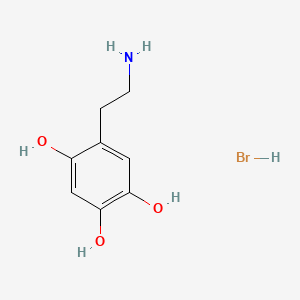



1. 6 Hydroxydopamine
2. 6-hydroxydopamine
3. 6-ohda
4. Hydrobromide, Oxidopamine
5. Hydrochloride, Oxidopamine
6. Oxidopamine
7. Oxidopamine Hydrobromide
8. Oxidopamine Hydrochloride
1. 636-00-0
2. Oxidopamine Hydrobromide
3. Oxidopamine (hydrobromide)
4. 6-hydroxydopamine Hbr
5. 6-ohda
6. 2,4,5-trihydroxyphenethylamine Hydrobromide
7. 5-(2-aminoethyl)benzene-1,2,4-triol Hydrobromide
8. 6-ohda Hbr
9. Mfcd00012894
10. Twc1d4w0wb
11. 2-(2,4,5-trihydroxyphenyl)ethylamine Hydrobromide
12. 1,2,4-benzenetriol, 5-(2-aminoethyl)-, Hydrobromide
13. 6-hydroxydopamine Hydrobromide;6-ohda Hydrobromide
14. Nsc-238469
15. 636-00-0 (hbr)
16. 6-hydroxydopamine Hydrogen Bromide
17. Mls002207128
18. 2,5-dihydroxytyramine Hydrobromide
19. Smr001306725
20. Einecs 211-247-0
21. Unii-twc1d4w0wb
22. Nsc 238469
23. 5-(2-aminoethyl)-4-hydroxypyrocatechol Hydrobromide
24. 5-(2-aminoethyl)benzene-1,2,4-triol;hydrobromide
25. 6-ohda Hydrobromide
26. 6-hydroxydopamine.hydrobromide
27. Schembl738049
28. 4-chlorobenzenecarbaldehydeoxime
29. Chembl1718398
30. Hy-b1081a
31. Dtxsid30212972
32. Wln: Z2r Bq Dq Eq &eh
33. Bcp25700
34. Ex-a4152
35. 6-hydroxydopamine Hydrobromide, 95%
36. Nsc238469
37. S5324
38. Akos015916618
39. Ccg-266959
40. Cs-5966
41. As-40064
42. Sy102034
43. Db-054509
44. B7099
45. Ft-0632700
46. M01851
47. 6-ohda Hydrobromide6-hydroxydopamine Hydrobromide
48. A935047
49. 1,4-benzenetriol, 5-(2-aminoethyl)-, Hydrobromide
50. 5-(2-aminoethyl)-1,2,4-benzenetriol Hydrobromide
51. 6-hydroxydopamine Hydrobromide, >=90% (hplc), Solid
52. Q27290460
53. 1,2,4-benzenetriol, 5-(2-aminoethyl)-, Hydrobromide (1:1)
54. 6-ohda Hbr; 6 Ohda Hbr;oxidopamine Hydrobromide; 6-hydroxydopamine Hbr
55. 6-hydroxydopamine Hydrobromide, Contains Ascorbic Acid As Stabilizer, >=98% (hplc)
| Molecular Weight | 250.09 g/mol |
|---|---|
| Molecular Formula | C8H12BrNO3 |
| Hydrogen Bond Donor Count | 5 |
| Hydrogen Bond Acceptor Count | 4 |
| Rotatable Bond Count | 2 |
| Exact Mass | 249.00006 g/mol |
| Monoisotopic Mass | 249.00006 g/mol |
| Topological Polar Surface Area | 86.7 Ų |
| Heavy Atom Count | 13 |
| Formal Charge | 0 |
| Complexity | 142 |
| Isotope Atom Count | 0 |
| Defined Atom Stereocenter Count | 0 |
| Undefined Atom Stereocenter Count | 0 |
| Defined Bond Stereocenter Count | 0 |
| Undefined Bond Stereocenter Count | 0 |
| Covalently Bonded Unit Count | 2 |
Sympatholytics
Drugs that inhibit the actions of the sympathetic nervous system by any mechanism. The most common of these are the ADRENERGIC ANTAGONISTS and drugs that deplete norepinephrine or reduce the release of transmitters from adrenergic postganglionic terminals (see ADRENERGIC AGENTS). Drugs that act in the central nervous system to reduce sympathetic activity (e.g., centrally acting alpha-2 adrenergic agonists, see ADRENERGIC ALPHA-AGONISTS) are included here. (See all compounds classified as Sympatholytics.)
Adrenergic Agents
Drugs that act on adrenergic receptors or affect the life cycle of adrenergic transmitters. Included here are adrenergic agonists and antagonists and agents that affect the synthesis, storage, uptake, metabolism, or release of adrenergic transmitters. (See all compounds classified as Adrenergic Agents.)